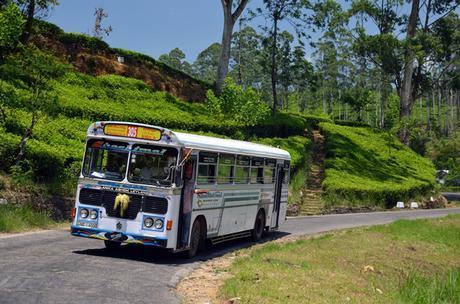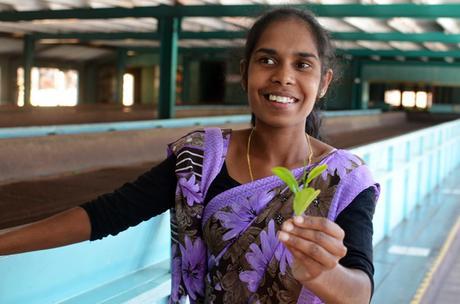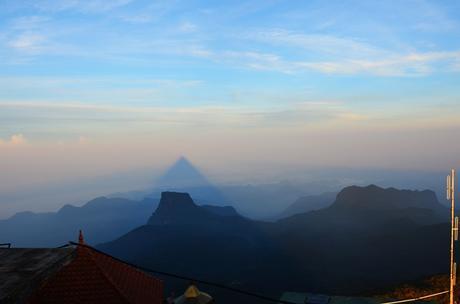
It’s very rare for us leave Totem to travel inland in countries we visit. This is mostly a function of money: we can’t afford the higher costs of living off the boat with restaurant meals and accommodations. It’s costly to buy the peace of mind of putting Totem in a marina instead of leaving her anchored out. It’s also about security. What if something happened when we were far away? Nobody looks after her like we do. So the decision to spend eight days traveling around the interior of Sri Lanka was a big deal. But our anchorage in Trinco was very well protected in this season, and the Utopia crew kept an eye on her for us.
The conventional wisdom about cruising in Sri Lanka is that it’s all about the inland experience. That might be partly because Galle sounds pretty unpleasant for boats, but it reflects the tremendously rich history and culture. So rich, it would be easy to spend a couple of months on inland travel, but we would manage with about a week.

long distance bus, on a major thoroughfare. coconut blossoms for luck on the grill.
We aimed for experiences in three big buckets: 1) the ancient cities (the ruins and relics of capitals from a few hundred to more than 2,000 years old) 2) Sri Lanka’s famed wildlife (at one of nearly two dozen national parks) and 3) the hill country (partly for the novelty of a cool climate, but also for a different cultural facet and to better understand colonial history). There are many, many ways to fulfill each of these, and by having general goals instead of a specific itinerary, we hoped to more organically find a path. Besides, I was suffering from a serious case of planning fatigue!

do your highways have cows ambling into traffic?
We took off to Kandy first: it’s only 113 miles, but the bus ride was nearly six hours from Trincomalee. Highways were often just winding country roads, and you can just expect to need to stop for a cow. But public transportation must be one of the best deals on the planet: the journey was less than $2 per person. I’m not sure how that even covers fuel costs, and will try not to think about vehicle maintenance.
Plains of rice paddies give way to hillsides of tea, waterfalls, and stunning vistas. Kandy is a historic capital: 200 years ago this month, it’s where Sri Lanka’s last independent kingdom ceded to colonial power. Because Kandy was the last holdout, there’s a more Sri Lankan culture evolved unfiltered (or squelched) by colonial interests. Possibly that’s what inspired Siobhan to spend her hard-earned money (selling baked goods at the weekly market in Langkawi) on seven meters of beautiful silk, fashioned into a Kandyan style sari.

Siobhan and her sari
In the market, cinnamon, nutmeg, and cloves (I’ve never seen fresh green cloves for sale before!) hint at Sri Lanka’s past as a trading crossroads in the Indian Ocean for bringing spice from the Far East to Europe. At the historic palace grounds include the Temple of the Tooth, with one of the most sacred of Buddhist relics. Yes, there’s supposed to be a real tooth from Gautama inside. We arrived on Poya, the full moon, an auspicious day for Sri Lankan Buddhists when pilgrims would be in greater numbers.

pilgrims…and school field trippers.
From Kandy, we spent a few days traveling through the hill country. Part of the appeal was the tea plantations: colonial relics that were the driver for infrastructure to bring coffee, then tea, to port; Sri Lanka remains one of the world’s largest exporters of tea. Part of the appeal was the cool climate at higher altitude. After so much time in the tropics, we were all kind of curious and excited to spend time in chilly weather. We got our wish! Overnight lows were around 50°F (10°C), and daytime temps hovered around 70°F (21°C). It was lovely.

learning about tea plantations and processing in a factory tour
It was slightly less lovely when we woke up to a 2:30 a.m. alarm in order to hike up Sri Pada. This 2,243 m (7,359 ft) tall peak is an important holy site thanks to a mark in the rock at the top resembling a footprint (claimed by Buddhists as Buddha’s, by Hindus as Shiva’s, and by Muslims and Christians as Adam or St Thomas’). Many pilgrims especially seek to see sunrise from the temple at the top, so that’s what we did too. Well, Niall and Jamie and I did. The girls decided they liked the warm blankets better!

Niall and I may have had sore legs for a week, but this goes down as one of my favorite experiences in Sri Lanka. It was humbling to climb (in many layers and proper shoes) next to pilgrims in bare feet with a towel for warmth, and I’ll not soon forget the sunrise puja. Also tremendous: seeing the shadow cast by the peak across the landscape to the west. Simply tremendous.

Next: wildlife in Wilpattu National Park.
Happy travelers know we love it when you read this on the Sailfeed website. Thank you!

